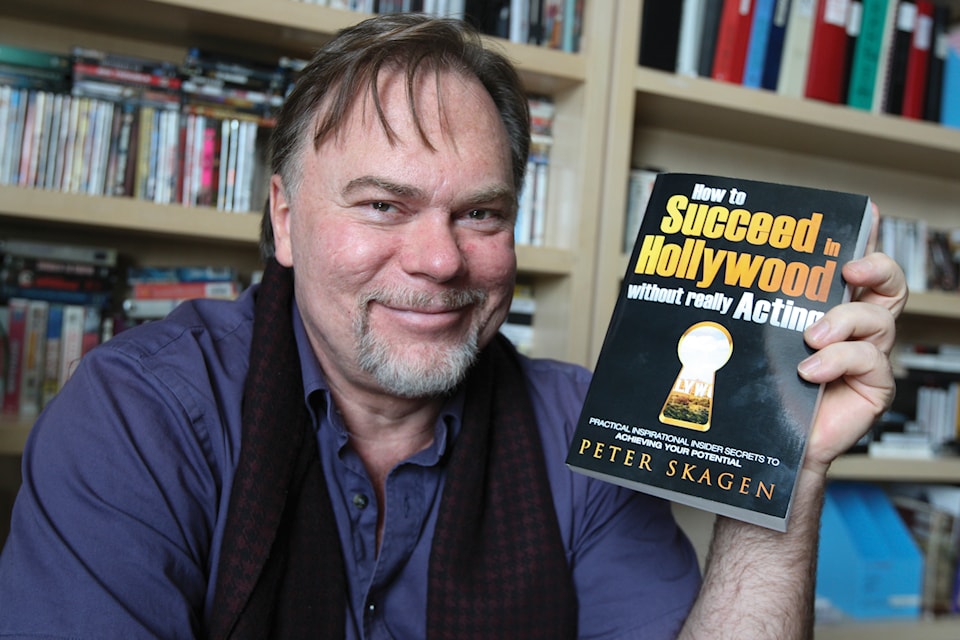Hollywood is a complicated place, but Calgary-based actor Peter Skagen is happy to decipher some of its unwritten rules for film students at Red Deer College.
Skagen, who’s written How to Succeed in Hollywood Without Really Acting, is guest teaching this month at Red Deer College’s Motion Picture Arts program.
With his practical guidebook to Hollywood being used as a textbook at the University of Lethbridge and Sheridan College in Toronto, Skagen’s presence in the classroom is a thrill for his friend, RDC acting instructor Larry Reese.
The benefit to up-and-coming actors from Skagen’s advice and experience is “huge,” added Reese, who considers the how-to book a valuable teaching tool.
“I wish I’d written it,” said Reese, who’s done a lot of film work, himself, including small roles in Unforgiven and Brokeback Mountain.
Skagen is a large, craggy man, who knows he projects an ambiguous good/bad guy image.
He’s had a slew of roles that proves this — from being cast as “the worst department store Santa ever” to a prison guard, FBI agent, mountain man, burly Confederate, and trailer park manager in various TV and movie projects, from September Dawn to Into the West, Hell on Wheels and Santa Baby Two: Christmas Maybe.
Skagen considers his own resume a testament to the fact Hollywood casting directors look for certain “types” to walk in the door.
Film students need to understand “what their outside says about them,” he said, so they can sell this brand of themselves at auditions.
For instance, there’s a good reason Jennifer Aniston always plays “the girl-next-door who doesn’t know she’s hot,” Hugh Grant is “Mr. Rom-com,” and Julia Roberts portrays “the girl who’s some trouble but is worth it,” said Skagen.
He lists Angelina Jolie as the femme fatale, Christopher Walken as the creepy guy, Jack Nicholson as the wild card, and Johnny Depp as the quirky outsider.
He advises film students to identify the type they project on camera — then to capitalize on it at auditions. Knowing your brand doesn’t mean you have to play a narrow range of roles — Skagen points out how Tom Hanks turned his “likeable American” persona into a varied and Oscar-winning career.
On the other hand, he admitted that some actors, like Clint Eastwood, do in fact have a pretty narrow, albeit “powerful,” range.
RDC film students are told that no Hollywood casting directors want to see acting going on. When somebody’s face is projected two storeys high, it’s easy to understand why.
Another lesson his book imparts is that movie actors have to fill in a lot of subtext. Skagen said screenplays are so minimalistic, the lines on the page usually don’t tell the whole story. “You have to be smart enough, as an actor, to understand the story at a deeper level” — because directors don’t do much directing, at least not in the form of giving actors detailed guidance. He said they’re too busy dealing with budgets, schedules, personalities and how the film will be shot.
Skagen, who has a master’s degree in film and screenwriting from California State University, has received a lot of good feedback on his new book, which also details how to audition, how to work on a set, and other basics.
He likes being “the guy in the Wizard of Oz who pulls the curtain back” to expose the inner working of a place that can be hard to figure out. “The students are great. It’s wonderful to see their eyes opened,” said the instructor, who’s taught workshops at many faculties, including Tisch School of the Arts at New York University.
He maintains, “Hollywood is not awful,” but there are some ugly truths.
Skagen admitted there are many more movie roles for men than women. Male actors also get to look more average and play more “types.”
Since female film characters tend to be sexualized, women actors have to be better looking. Although there are opportunities for them to start acting as teens or even children, they have a limited shelf life — up to about age 45, when they disappear, only to reappear, in some cases, in grandmother roles in their 60s. The exceptions, he said, are funny women, like Rosie O’Donnell, Ellen DeGeneres, Tina Fey and Amy Poehler.
But that’s Hollywood.
Skagen said it’s an illusory industry based on appearances, so looks do matter.
“It can be incredibly heart-breaking and difficult ... but can you be a singer and not know how to sing?”
Has he ever had to tell any students that they probably won’t cut it in Hollywood?
Skagen admits he’s never had to. “Nobody’s ever asked me.”
How to Succeed in Hollywood Without Really Acting is available from Amazon, Kindle Books and other sellers, or from poubellepublishing.com.
lmichelin@www.reddeeradvocate.com
